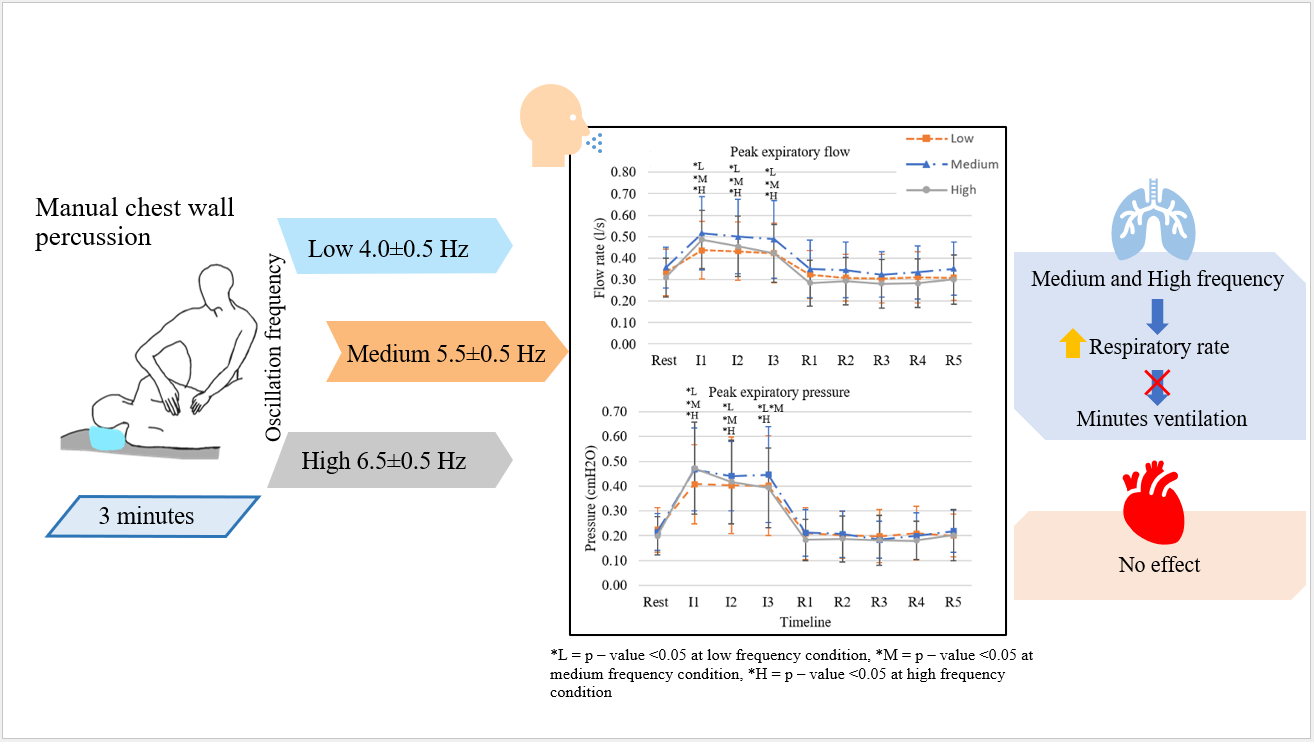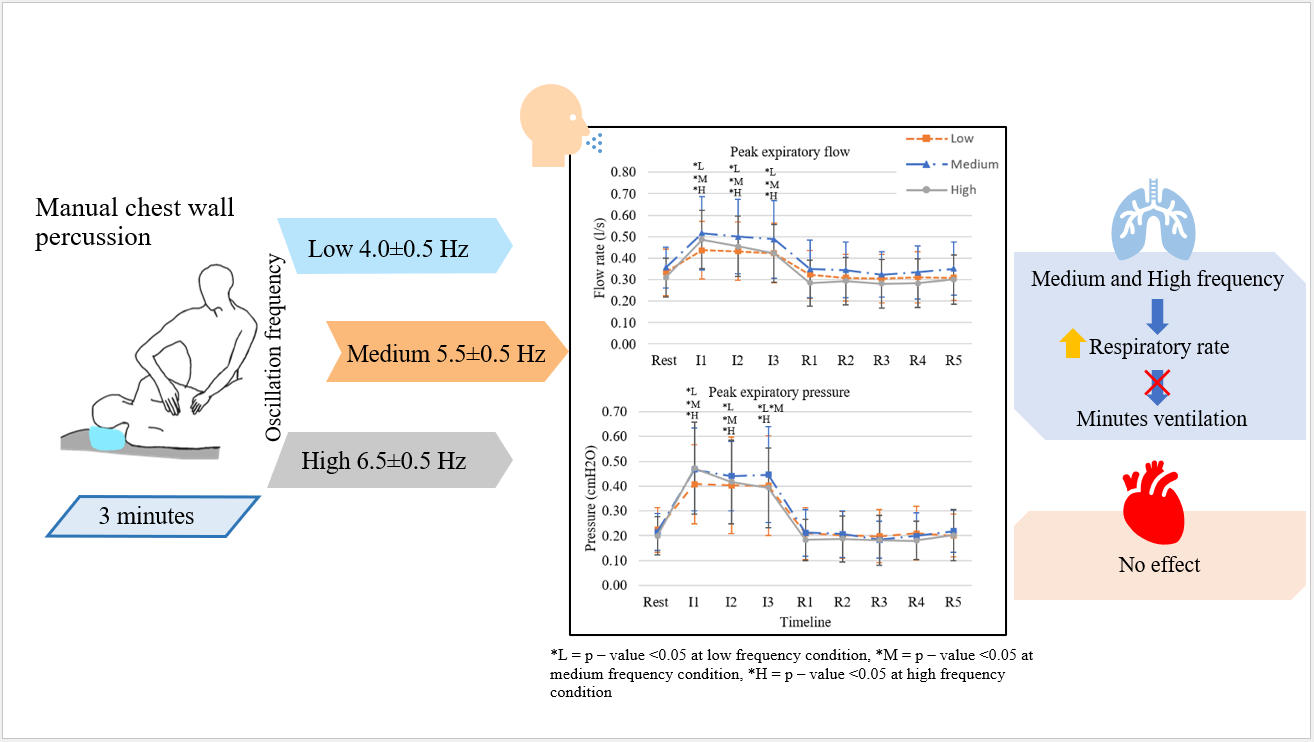The Flow-Pressure and Cardiopulmonary Responses of Manual Chest Percussion with Different Ranges of Oscillation Frequency in Healthy Subjects
DOI:
https://doi.org/10.48048/tis.2024.7345Keywords:
Manual percussion, Chest physical therapy, Airway clearance technique, Convention chest physical therapy, Bronchial hygiene therapyAbstract
Manual chest wall percussion (MP) is a technique for secretion clearance which commonly use. However, MP is performed by physiotherapists throughout a broad range of the oscillation frequency, which might result in different physical properties and cardiopulmonary responses of MP. Investigate the flow, pressure and cardiorespiratory response during MP with 3 frequencies in healthy subjects. Twenty-one healthy subjects (8 men and 13 women) were recruited into this crossover study. MP was applied with 3 frequency ranges, including low (4.0 ± 0.5), medium (5.5 ± 0.5), and high (6.5 ± 0.5) Hz, for 3 min in the neutral side lying on left side. A flow sensor (Model SS11LA) and a pressure sensor (Model SS13L) were used to measure Inspiratory-expiratory (I-E) flow rate and pressure through mouth. A bedside monitor (BSM 2351k, Nihon Kohden) was used to measure cardiopulmonary response. All dependent variables were measured pre- (resting), during, and post- (recovery) MP application. Both I-E flow rate and pressure were increased from resting significantly in all frequencies MP, but they were not different among the 3 frequency ranges. The E flow rate was increased to 0.41 - 0.44, 0.49 - 0.52 and 0.41 - 0.49 L/s (min-max) during MP application at low, medium, and high frequency compared to resting (0.31 - 0.36 L/s), respectively. The E pressure was increased to 0.40 - 0.41, 0.44 - 0.47 and 0.39 - 0.47 cmH2O (min-max) during MP application at low, medium, and high frequency compared to resting (0.20 - 0.22 cm H2O), respectively. However, the increment of the 3 frequency ranges did not affect the cardiovascular functions except respiratory rate, which was increased only 2 breaths/min from resting. In conclusion, airflow and pressure were slightly increased during MP but did not affect cardiopulmonary functions in healthy subjects. Further study in patients is needed.
HIGHLIGHTS
- Manual chest wall percussion is a secretion clearance technique which commonly used.
- Whether manual chest wall percussion frequency is capable of increasing expiratory flow rate by the same amount.
- The percussion force might be the most prominent factor affecting the expiratory flow rate.
- The frequency of chest wall percussion does not affect cardiovascular response.
- Medium and high frequencies cause a minor rise in the respiratory rate but have no impact on minute ventilation.
GRAPHICAL ABSTRACT

Downloads
Metrics
References
CPVD Schans. Conventional chest physical therapy for obstructive lung disease. Respir. Care 2007; 52, 1198-206.
J Rodrigues and J Watchie. Cardiovascular and pulmonary physical therapy treatment. In: J Watchie (Ed.). A clinical manual. 2nd eds. WB Saunders, Philadelphia, 2010, p. 298-392.
B Langenderfer. Alternatives to percussion and postural drainage: A review of mucus clearance therapies. J. Cardiopulm. Rehabil. Prev. 1998; 18, 283-9.
JA Pryor. Physiotherapy for airway clearance in adults. Eur. Respir. J. 1999; 14, 1418-24.
CC Zadai. Physical therapy for the acutely ill medical patient. Phys. Ther. 1981; 61, 1746-54.
D Clinkscale, K Spihlman, P Watts, D Rosenbluth and MH Kollef. A randomized trial of conventional chest physical therapy versus high frequency chest wall compressions in intubated and non-intubated adults. Respir. Care 2012. 2012; 57, 221-8.
BK Rubin. Secretion properties, clearance, and therapy in airway disease. Transl. Respir. Med. 2014; 2, 6.
B Button, HP Goodell, E Atieh, YC Chen, R Williams, S Shenoy, E Lackey, NT Shenkute, LH Cai, GR Dennis, RC Boucher and M Rubinstein. Roles of mucus adhesion and cohesion in cough clearance. Proc. Natl. Acad. Sci. 2018; 115, 12501-6.
XM Bustamante-Marin and LE Ostrowski. Cilia and mucociliary clearance. Cold Spring Harb. Perspect. Biol. 2017; 9, a028241.
RP Tomkiewicz, A Biviji and M King. Effects of oscillating air flow on the rheological properties and clearability of mucous gel simulants. Biorheology 1994; 31, 511-20.
KA Flower, RI Eden, L Lomax, NM Mann and J Burgess. New mechanical aid to physiotherapy in cystic fibrosis. Br. Med. J. 1979; 2, 630.
S Blazey, S Jenkins and R Smith. Rate and force of application of manual chest percussion by physiotherapists. Aust. J. Physiother. 1998; 44, 257-64.
WP Wong, JD Paratz, K Wilson and YR Burns. Hemodynamic and ventilatory effects of manual respiratory physiotherapy techniques of chest clapping, vibration, and shaking in an animal model. J. Appl. Physiol. 2003; 95, 991-8.
B Audsavachulamanee, S Aueyingsak, C Ubolsaka-Jones, N Kosura, J Chanapon, N Yubonpan and C Phimphasak. Thai physiotherapists’ performance of manual chest wall percussion on an artificial lung: Frequency, force, and fatigue perception. Arch. Med. Health Sci. 2023; 35, 23-34.
B McCarren and J Alison. Physiological effects of vibration in subjects with cystic fibrosis. Eur. Respir. J. 2006; 27, 1204-9.
P Imle. Percussion and vibration. In: CF Mackenzie, PC Imle and M Ciesla (Eds.). Chest physiotherapy in the intensive care unit. 2nd eds. Williams and Wilkins, Baltimore, 1989, p. 134-52.
AF Connors, WE Hammon, RJ Martin and RM Rogers. The immediate effect on oxygenation in acutely ill patients. Chest 1980, 78, 559-64.
WE Hammon, DR McCaffree and AJ Cucchiara. A comparison of manual to mechanical chest percussion for clearance of alveolar material in patients with pulmonary alveolar proteinosis (phospholipidosis). Chest 1993; 103, 1409-1412.
C Jones. Physical therapy respiratory system techniques and assessment. Klungnana Vitthaya Press, Khon Kaen, Thailand, 2014, p. 101-25.
J Leelarungrayub. Clinical chest physiotherapy. Thammasat Book, Bangkok, Thailand, 2014, p. 133-95.
K Dallimore, S Jenkins and B Tucker. Respiratory and cardiovascular responses to manual chest percussion in normal subjects. Aust. J. Physiother. 1998; 44, 267-74.
D Vines and D Gardner. Airway clearance therapy (ACT). In: RM Kacmarek, JK Stoller and AJ Heuer (Eds.). Egan’s fundamental of respiratory care. 11th eds. Elsevier, Missouri, 2017, p. 951-70.
BL Graham, I Steenbruggen, MR Miller, IZ Barjaktarevic, BG Cooper, GL Hall, TS Hallstrand, DA Kaminsky, K McCarthy, MC McCormack, CE Oropez, M Rosenfeld, S Stanojevic, MP Swanney and BR Thompson. Standardization of spirometry 2019 update. An official American thoracic society and European respiratory society technical statement. Am. J. Respir. Crit. Care Med. 2019; 200, e70-e88.
BM Button and B Button. Structure and function of the mucus clearance system of the lung. Cold Spring Harb. Perspect. Med. 2013; 3, a009720.
W Poncin, G Reychler, M Liistro and G Liistro. Comparison of 6 oscillatory positive expiratory pressure devices during active expiratory flow. Respir. Care 2020; 65, 492-9.

Downloads
Published
How to Cite
Issue
Section
License
Copyright (c) 2023 Walailak University

This work is licensed under a Creative Commons Attribution-NonCommercial-NoDerivatives 4.0 International License.






